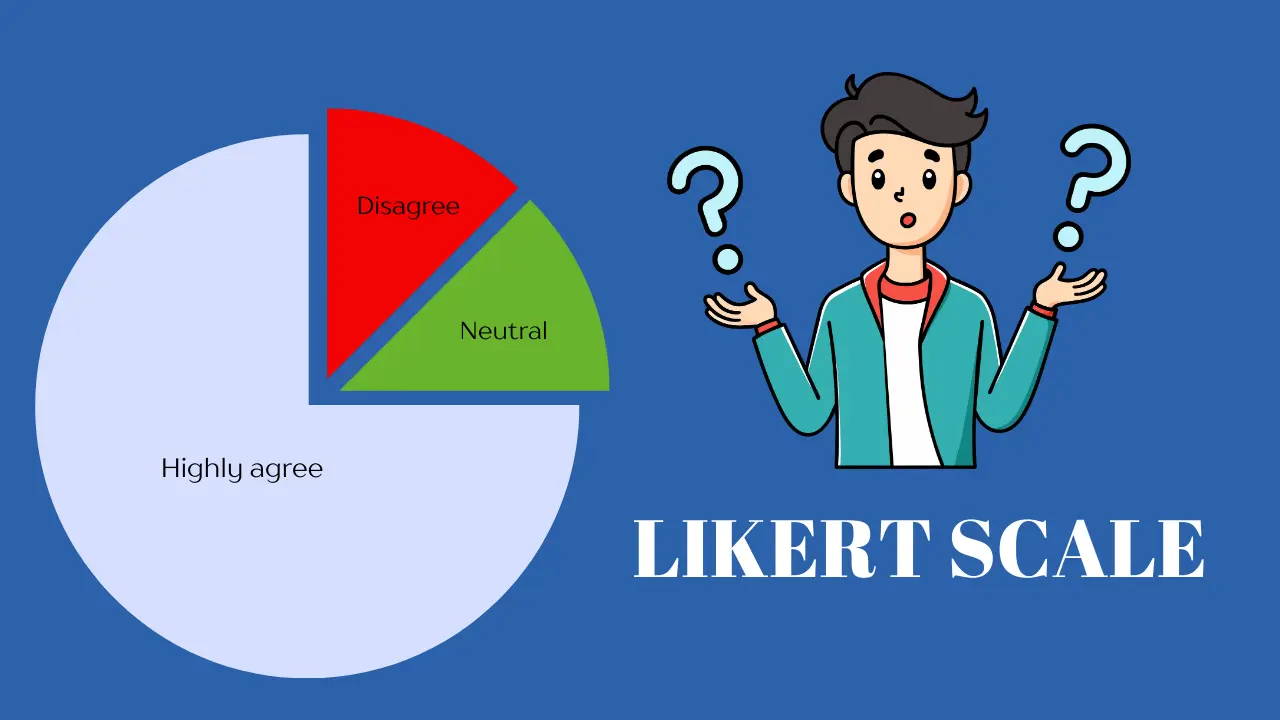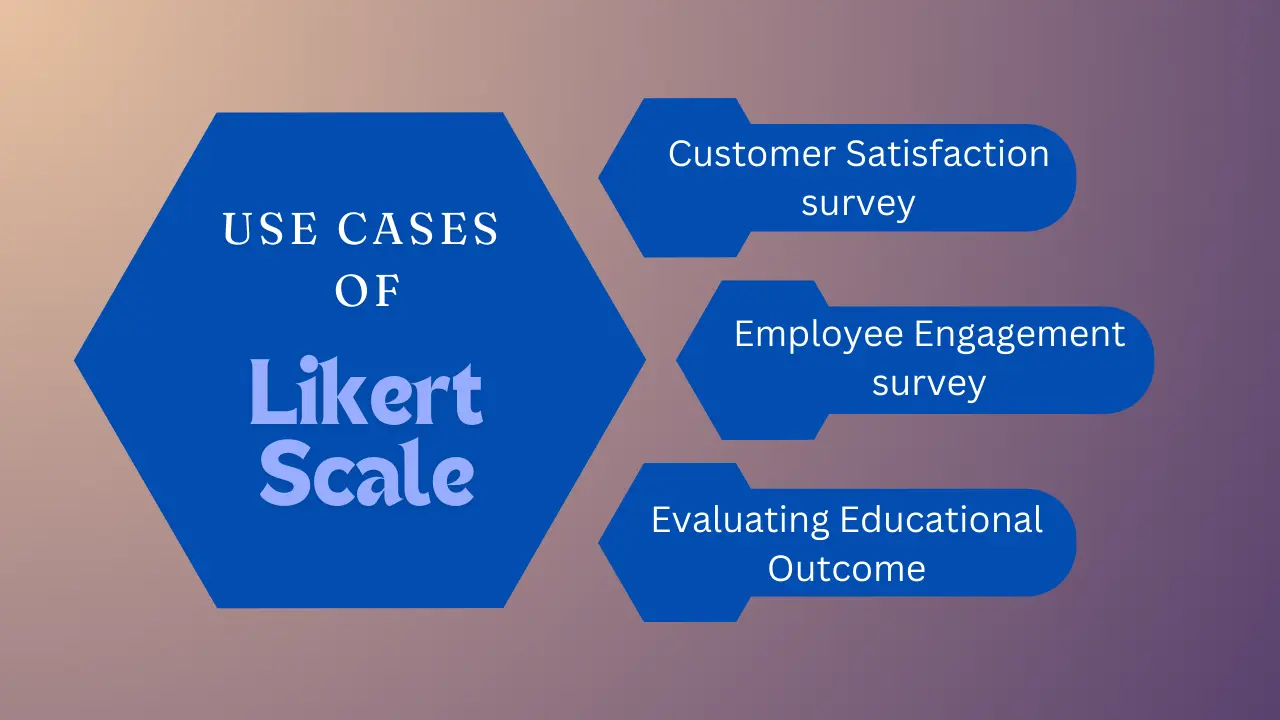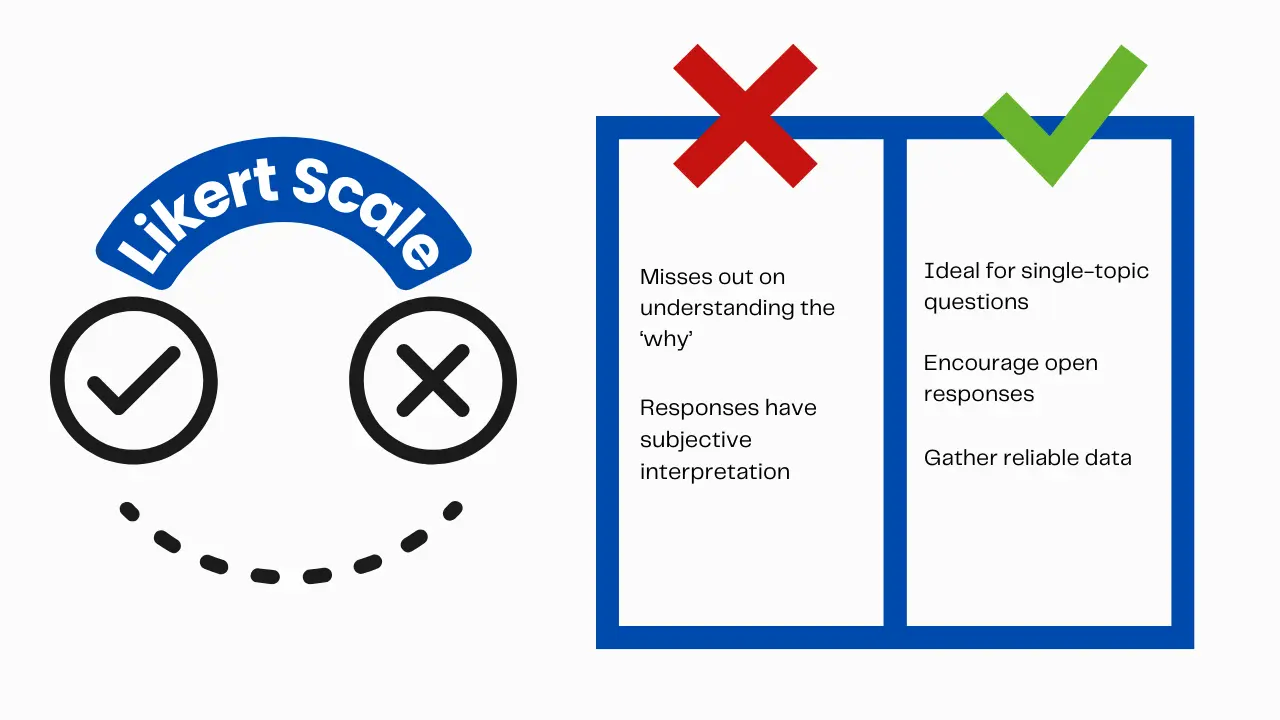Consider the challenge of turning subjective feelings into something measurable. Whether gauging consumer satisfaction, employee engagement, or public opinion, understanding how people truly feel is far from straightforward.
The Likert scale, the tool many may have encountered without even realizing it, offers a clever solution. It provides a way to capture the subtle gradations in human attitudes.
But its true genius lies in its ability to break down our feelings and opinions into something we can measure and analyze.
As we dive into this survey scale tool, we’ll explore the Likert scale format and how it translates the intangible into data.
Table of Contents
What is the Likert Scale?
To understand a Likert rating scale, it’s important first to recognize what a survey scale is. Essentially, a survey scale provides a set of answer choices—either in words or numbers—that reflect a range of opinions or feelings on a given subject. It’s commonly used in structured, closed-ended questionnaires.

A Likert scale, in particular, is a type of rating scale designed to measure people’s attitudes, feelings, and opinions. It presents a range of responses, usually from one extreme to another, and sometimes includes a neutral middle option. The 4- to 7-point scale is the most frequently used in surveys.
What makes Likert-scale questions so versatile is their ability to adapt to various contexts, whether it’s gauging employee satisfaction, customer feedback, or quality assessment.
For example, instead of asking a simple yes-or-no question like “Are you satisfied with current team collaboration?” a Likert scale question provides a broader range of responses, such as “extremely satisfied” to “extremely dissatisfied,” allowing for more nuanced feedback.
Types of Likert Scale Questions
Now that you know about the Likert scale, it’s time to dive a bit deeper into the various types. The biggest advantage of using Likert survey scale questions is they can be used for a variety of topics.
Here are a few of the most commonly used question types.
1. Satisfaction survey scale – These scales assess the degree of satisfaction with a product, service, or experience. The options typically range from “Very Satisfied” to “Very Dissatisfied.”
How satisfied are you with the customer service you received?”
- Very Satisfied
- Satisfied
- Neutral
- Dissatisfied
- Very Dissatisfied
2. Importance Survey scale – Importance scales evaluate how critical a certain factor is to the respondent. These questions typically range from “Very Important” to “Not Important at All.”
“How important is work-life balance to you?”
- Very Important
- Important
- Neutral
- Unimportant
- Not Important at All
3. Likelihood survey scale – These scales measure the probability or how likely someone is to do something instead of just how much they like an idea of something — it is more of a future action or behavior, ranging from “Very Likely” to “Very Unlikely.”
How likely are you to recommend our product to a friend?”
- Very Likely
- Likely
- Neutral
- Unlikely
- Very Unlikely
4. Frequency Survey scale – This type of Likert scale format question is great for measuring how often something occurs, capturing behaviors or experiences over time. The options usually range from “Always” to “Never.”
How often do you use our mobile app to make purchases?
- Always
- Often
- Sometimes
- Occasionally
- Never
When to use the Likert Scale [survey scale use cases]

Likert scale questions are ideal for evaluating responses across various dimensions, like satisfaction, quality, importance, and likelihood. They are particularly useful when you need more detailed insights than a simple “yes or no” question can provide.
For example, let’s say you’re gathering customer feedback on a new product. You might ask, respondents “Are you satisfied with the product you purchased?”
- Yes
- No
This type of dichotomous question offers very limited information. But if you want to get deeper and understand the specific level of satisfaction your customers have with the product, then using the Likert scale would be more effective –
“Are you satisfied with the product you purchased?”
- Very satisfied
- Satisfied
- Unsure
- Dissatisfied
- Very dissatisfied
Using a survey scale like this allows you to capture further nuanced feedback, pivotal for measuring intangible factors like feelings, opinions, or attitudes that influence consumer behavior. This approach leads to more accurate and practicable insights.
There are many cases where Likert Scale format questions are highly used –
- Customer Satisfaction Survey – Likert scales are ideal for gauging how satisfied customers are with products, services, or overall experiences, allowing companies to identify strengths and areas for improvement.
- Employee engagement survey – This type of survey measures how aligned and committed employees are with company values and goals. Insights from surveys can indicate the health of the business and you can stay informed about how employees feel about life in your company.
- Evaluating Educational Outcomes – In this type of survey, educators and researchers use Likert scales to assess students’ perceptions of course content, teaching methods, and overall satisfaction, contributing to curriculum development and instructional improvement.
Advantages and Disadvantages of Likert Scales
Using a survey scale like the Likert style has its advantages and drawbacks. If you’re considering incorporating it into your survey, it’s important to understand both the benefits it offers and the limitations it may present.

Pro – Ideal for single-topic questions in survey
A Likert scale is ideal for a series of questions focused on a single topic in a survey, as it provides more accurate results. It allows you to easily analyze responses, gauge opinions or feelings, and summarize results from a few questions.
For instance, you might start with a question like:
1. How easy is it to navigate the website and find what you’re looking for?
You can then follow up with questions such as:
2. How satisfied are you with the product descriptions and images provided?
3. How would you rate the ease and speed of the checkout process?
By following this process, you can gather precise feedback, enabling you to assess whether your website’s user interface is user-friendly and identify any problem areas more accurately.
You can add one question for another section of the survey and follow-up questions from the initial question.
Pro – They encourage open responses
Unlike binary options like “yes or no” or “true or false,” a Likert scale offers more flexibility in responses.
By using unipolar or bipolar scales, you give respondents the freedom to express their true opinions without feeling pressured.
But when dealing with complex topics, some people might feel compelled to answer a less extreme response to avoid being perceived a certain way.
In that case, it’s important to reassure your respondents that survey responses are confidential and anonymous.
Pro – The Likert-style questions gather reliable data
Likert scales provide a more detailed capture of opinions and attitudes than binary questions.
For example, if customers use a “product or service occasionally but not regularly, a binary question like “Do you prefer to use our service”? Forces them to choose either yes or no, making it nearly impossible to understand the actual level of preference or usage of the service.
In contrast, Likert scale questions improve the quality of survey data by offering more accurate and nuanced responses, leading to more reliable insights from survey takers.
Pro – Practical in any circumstance
Likert-style questionnaires can be utilized in any circumstance where you want to evaluate and understand the preferences, opinions, sentiments, or behaviors of customers.
You can use it to determine whether clients are satisfied with your service. Or use it to understand your employees’ opinions on working with your company.
You can implement them in a standard questionnaire, or use site intercepts on specific pages. You could have a Likert scale questionnaire pop up after a webinar to get feedback on content.
Con – It misses out on understanding the reasons
Likert scales are close-ended questions so they help determine how your employees, customers, or target market think about your company, service, or products, but just like any other quantitive data collected from close-ended questionnaires, it doesn’t offer the “why” aspect of their opinions.
For example, you may find out that your customers are not satisfied with your cosmetic product, but Likert scales don’t tell why they are not satisfied suggest what made them feel that way, or suggest what you can change to improve customer satisfaction.
With this in mind, to increase the accuracy of your survey data, plan your survey design with both open-ended and close-ended questions to help address the problem and its “why.”
Con – Likert scale responses have subjective interpretation
The interpretation of Likert scale points may vary depending on individuals. People may choose scale options based on the extremity of their opinions and attitudes differently.
One person’s “somewhat agree” might be another’s “strongly agree.” Besides, if the respondent thinks their answers might somehow affect their reputation or they want to be politically correct, they’ll pick responses accordingly.
To reduce the potential subjectivity issue, researchers must make sure they choose Likert scales with the right number of scale points.
How to Write Likert Scale Survey Questions
Determine whether to ask questions or make statements
Decide if you want to list down a series of questions for the survey scale or pose statements. Using questions instead of statements is the best way to get accurate data from your survey.
Statements pose risk – as most people tend to agree with a statement rather than disagree. This is because people tend to choose positive statements more frequently.
Let’s consider this example – “How satisfied are you with your current job role?” versus “I am satisfied with my current job role.”
Though subtle differences exist between the two Likert scale examples, the question allows you to choose a certain degree of satisfaction. On the other hand, the statement encourages a biased response with the three words – “I am satisfied.”
So, try to inculcate questions more but if you want to add a statement write it in a way that doesn’t encourage a certain option scale.
Choose unipolar or bipolar options
A unipolar scale focuses on a single dimension, like asking how frequently something occurs, with options ranging from “Never, Rarely, Sometimes, Often, Always.”
Bipolar scales, however, capture a spectrum of opposites, such as “Strongly Disagree” to “Strongly Agree” with a midpoint being a neutral or ambivalent stance.
Your choice here shapes how you capture the range of respondent opinions—whether you’re measuring the intensity of one sentiment or the balance between two opposing views.
Use positive and negative framing for balance
To avoid bias, mix both positively and negatively framed questions or statements for the Likert scale survey.
If every statement or question leans in one direction, respondents might start answering automatically without fully considering each item.
By balancing the framing, you encourage thoughtful responses and get a more accurate reflection of their true opinions.
Decide on the survey scale
Choose the number of points on your scale carefully. A 5-point scale is common and offers a balance between simplicity and detail, while a 7-point scale can capture more nuanced responses. More points give finer distinctions but can also overwhelm respondents.
Suppose you’re surveying employees about their satisfaction with remote work. You could use a 5-point scale like this:
- 1 – Very Dissatisfied
- 2 – Dissatisfied
- 3 – Neutral
- 4 – Satisfied
- 5 – Very Satisfied
This 5-point scale is easy for employees to understand and provides clear categories for their responses. If you want to capture more subtle differences in satisfaction, you might choose a 7-point scale:
- 1 – Extremely Dissatisfied
- 2 – Very Dissatisfied
- 3 – Dissatisfied
- 4 – Somewhat Satisfied
- 5 – Satisfied
- 6 – Very Satisfied
- 7 – Extremely Satisfied
The key is to select a scale that fits your needs and is easy for respondents to use.
Be consistent and clear with scales
When creating a Likert scale survey, maintaining consistency and clarity in your scale options is essential for gathering accurate data. Once you choose a format for your scale—such as starting with “Strongly Disagree” on the left and “Strongly Agree” on the right—stick with that format throughout the entire survey.
This consistency helps respondents become familiar with the structure, reducing confusion and ensuring that their answers reflect their true opinions.
In addition to consistency, clarity in your scale labels is key. Use straightforward and unambiguous language so that respondents clearly understand what each option represents.
For instance, if you’re asking about job satisfaction, avoid vague labels like “Okay” or “Fine,” which can be interpreted differently by different people. Instead, use precise terms like “Satisfied” or “Neutral” to ensure that everyone understands the options in the same way.
Clear, consistent scales lead to more meaningful insights and better decision-making based on the survey results.
How to Analyze Data of Likert Scale Responses
After creating a Likert scale survey, half the work is done, but analyzing the data is crucial to understanding the results.
Since Likert scales are ordinal, calculating means or averages won’t give you meaningful insights. Instead, focus on the median or mode to analyze the data effectively. Look at how responses are distributed across the scale and summarize the percentage for each category. Visualizing this with bar graphs can make it easier to interpret.
For example, if 70% of respondents “somewhat agree” that your customer service is satisfactory, this indicates a positive trend.
You can also combine Likert scale points into broader categories. For instance, when measuring customer satisfaction, you might group “somewhat satisfied” and “highly satisfied” responses together to find the total percentage of customers with a positive outlook.
While Likert scales are excellent for gathering data, keep in mind that responses can still be influenced by social bias. People may answer in ways they believe are socially acceptable, so consider this when interpreting the results.
Create a Likert Scale Survey
If you are planning to create your own Likert scale survey for your WordPress website, then the Quiz and Survey Master plugin is an excellent tool to get the job done. Here’s how you can set it up;
- Install the Plugin – You have to first install the plugin in your WordPress dashboard, then click on “Create New Quiz/Survey” to create a survey.
- Add You Questions – The plugin offers various question types; for a Likert scale survey, select either the Polar Question or Radio Grid question type to structure your survey effectively.
You can add questions section-wise by choosing to include different section questions on a new page.
- Customize the Survey Form – The QSM plugin offers you multiple options like displaying a progress bar, scheduling dates to take the survey, restricting user attempts, etc.
Besides, you can even set up email templates to be shared with your users once they submit the survey. But before that, create the contact form and include the Email field.
- Publish and Embed the Survey – After finalizing your survey, click “Publish.” You can copy the shortcode from the Quizzes/Surveys page, and embed it into any page or post on your website where you want the survey to appear.
- Analyze Your Survey Data – QSM also offers premium add-ons for data analysis. You can use tools like the Google Sheets Connector and Google Analytics Tracking to gather all your survey data in one place and analyze the results easily.
If you want to know more about how to create a survey in QSM, then you can check this article – How to Create a Survey Form in WordPress. Know that Creating a survey in QSM is similar to creating a quiz.
FAQs
What is the 5-point Likert scale?
The Likert scale is a psychological response scale in which the survey takers specify their level of agreement at five points naming: strongly agree, agree, neutral, disagree, and strongly disagree.
How do you create a Likert scale survey?
You can create a Likert scale survey using the Quiz and Survey Master plugin for WordPress. You would require the Advance Questions Type addon that allows you to use the radio grid button.
Is a Likert scale a survey?
The Likert scale is a psychometric scale that is used in survey questions that are based on it. It is one of the most popular sorts of survey questions.




